Houseplants can turn your home into a green paradise. But, with so many options, picking the right ones can be tough.
What You’ll Learn in This Guide
In this guide, you’ll learn how to pick the right houseplants for your space. We’ll cover light, temperature, and humidity needs. There are special sections for low-light plants, small plants for small spaces, and the top 100 houseplants for different needs.
We’ll also share important care tips. These include watering, soil, and fertilizers to keep your indoor garden healthy all year.
Introduction
Houseplants are more than just decorations. They improve air quality, boost mood, and spark creativity by bringing nature indoors. From plants that remove toxins to pet-safe options, there are many benefits. This guide explores these advantages and offers tips on choosing and caring for houseplants.
Why Houseplants Matter
Houseplants are key to a healthier home. They naturally clean the air by removing toxins like formaldehyde and benzene. Adding air-purifying indoor plants not only improves air quality but also adds beauty. They also help reduce stress, improve mood, and enhance overall wellbeing.
For pet owners, picking pet-safe houseplants is crucial. These plants are safe for pets and won’t harm them if eaten. In this guide, you’ll learn about air-purifying plants and how to pick the best ones for your home.
What You’ll Learn in This Guide
This comprehensive guide covers everything you need to know about indoor gardening. Here’s what you can expect:
- Choosing the right houseplant: Learn about light, water needs, and how to pick air-purifying indoor plants.
- Essential care tips: Get advice on watering, light, soil, fertilizers, and repotting to keep your plants healthy.
- Recommended tools and accessories: Discover the best self-watering pots, grow lights, and other must-haves for houseplants.
- Comprehensive plant profiles: Find detailed descriptions of over 100 popular houseplants, including their care needs and benefits.
| Houseplant | Watering Schedule | Light Needs | Notes |
|---|---|---|---|
| Snake Plant | Every 2-4 weeks | Low to Medium Light | Low maintenance and excellent air-purifying indoor plant. |
| Jade Plant | Every 2 weeks | High Light | Ideal for sunny spots and easy care. |
| Pothos | Every 10-14 days | Low to Medium Light | Great for beginners; tolerant of varying conditions. |
| Fiddle Leaf Fig | Every 10-14 days | High Light | Can be challenging; needs bright, indirect light. |
With this guide, you’ll be ready to start and keep a lively collection of houseplants. They’ll clean the air and brighten your space.
How to Choose the Right Houseplant
Choosing the right houseplant is more than just picking something pretty. It’s about matching the plant to your home’s environment, lifestyle, and taste. Whether you’re looking for big indoor plants or ones that love humidity, think about a few important things first.
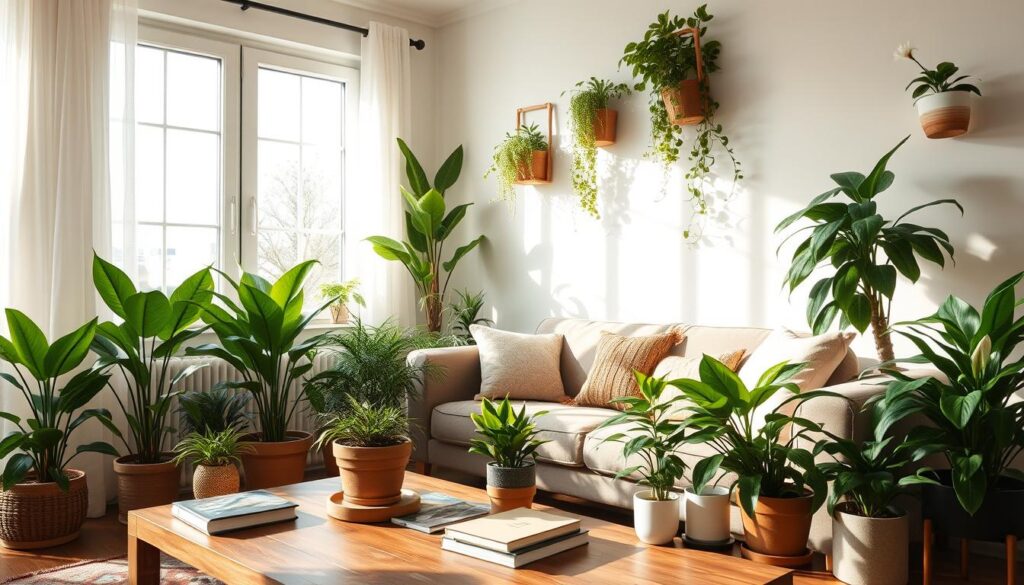
Key Factors to Consider
- Lighting Conditions: Indoor light can vary a lot. Some plants need bright, indirect light, while others do well in low light. Direct sunlight in summer can burn leaves, so use curtains. Plants near north windows might struggle in winter. Check your home’s light before picking a plant.
- Temperature Fluctuations: Plants don’t like sudden temperature changes. Keep them away from heaters, drafts, and cold spots at night. Watch the temperature to place your plants right.
- Humidity Levels: Some plants, like orchids, love moist air. Others, like cacti, prefer dry air. Think about your home’s humidity when picking a plant.
- Watering Requirements: Plants need different amounts of water. Some, like Peace Lilies, need more water, while others, like cacti, need dry soil. Know what your plant needs to care for it right.
- Maintenance Load: If you’re new to plants or don’t have much time, choose easy-care plants like ZZ plants. Many people pick low-maintenance plants because they’re busy. About 30% of houseplants can handle low light, great for offices or small spaces.
- Aesthetic Appeal: About 70% of people pick plants for how they look. Make sure your plant fits your home’s look and needs. Plants like Monstera are popular for their looks and easy care.
By considering these factors, you’ll pick the best plants for your home. Knowing how to choose the right plant means you’ll have a beautiful, thriving indoor garden. It will meet your style and practical needs.
Explore the 100 Best Houseplants
Houseplants make your home look better and are good for your health. Whether you’re new to plants or have a green thumb, picking the right ones is important. Find the best indoor plants for beginners and those that do well in low light, among others. We want to help youhow to grow healthy houseplants as well as create an environmement that your plants and loved ones will love.
12 Best Houseplants for Beginners
Starting with houseplants can seem tough, but these plants are easy to care for. These easy-care houseplants will allow you to create a healthy and attractive environment to grow in. Here are 12 variaties that need little attention:
- 1. Snake Plant – Nearly indestructible, thrives in low light and requires minimal watering.
- 2. ZZ Plant – Handles low light and infrequent watering, perfect for busy plant owners.
- 3. Pothos – A fast-growing vine that thrives in almost any condition, great for beginners.
- 4. Spider Plant – Air-purifying and adaptable, easy to grow with minimal care.
- 5. Peace Lily – Elegant and air-purifying, thrives in moderate light with weekly watering.
- 6. Philodendron – Low-maintenance with beautiful trailing vines, perfect for indoor spaces.
- 7. Cast Iron Plant – Almost impossible to kill, tolerant of neglect and low light.
- 8. Chinese Evergreen – Tough and adaptable, grows well in low to moderate light.
- 9. Dumb Cane – Striking foliage, thrives in medium light and requires little upkeep.
- 10. Heartleaf Philodendron – Hardy and fast-growing, excellent for hanging baskets.
- 11. Parlor Palm – A classic, easy-care palm that thrives in indirect light.
- 12. Dracaena – Tall, elegant, and air-purifying, needs occasional watering.
10 Best Low-Light Houseplants
The varieties that we have shared below are some of the best houseplants for low light.
Not all homes get a lot of sunlight. Many of these plants are low-maintenance indoor plants that are very easy to grow and maintain. These plants do well in low light, perfect for dark corners or rooms with little sun:
- 13. ZZ Plant – Almost maintenance-free, handles low light and infrequent watering.
- 14. Cast Iron Plant – Thrives in the darkest corners with little care.
- 15. Parlor Palm – A stylish, low-maintenance palm that adapts to various light conditions.
- 16. Peace Lily – Produces beautiful white flowers even in low light.
- 17. Chinese Evergreen – Adapts to low light and requires minimal watering.
- 18. Boston Fern – A lush, humidity-loving fern that thrives in shaded spots.
- 19. Nerve Plant – Colorful veined leaves, perfect for terrariums and low-light spaces.
- 20. Prayer Plant – Folds its leaves at night, adding life to dimly lit rooms.
- 21. Lucky Bamboo – Can grow in water and thrives in indirect light.
- 22. Maidenhair Fern – Delicate and elegant, thrives in humid, low-light spaces.
12 Best Succulents & Cacti for Indoors
Succulents and cacti are popular for their unique looks and toughness. They’re great for those who like easy-to-care-for plants:
- 23. Aloe Vera – Medicinal and low-maintenance, thrives in bright light with little water.
- 24. Jade Plant – A symbol of prosperity, requires minimal care and bright light.
- 25. String of Pearls – A stunning trailing succulent with bead-like leaves.
- 26. Haworthia – Compact and resilient, grows well in small pots.
- 27. Christmas Cactus – Produces beautiful holiday blooms with proper care.
- 28. Burro’s Tail – Cascading succulent with plump, trailing leaves.
- 29. Echeveria – A rosette-shaped succulent that loves sunlight and dry soil.
- 30. Zebra Plant – A hardy, striped succulent that thrives in bright light.
- 31. Prickly Pear Cactus – A striking cactus that thrives in sunny windowsills.
- 32. Bunny Ear Cactus – Fuzzy and cute, but with sharp spines, needs minimal water.
- 33. Crown of Thorns – A flowering succulent that blooms year-round in bright light.
- 34. Paddle Plant – Unique, flat-leafed succulent that thrives in sunlight.
10 Small Houseplants for Compact Spaces
Make the most of small spaces with these compact plants that add style:
- 35. Air Plants – Survive without soil, just mist them occasionally.
- 36. Baby Rubber Plant – Compact and resilient, with thick glossy leaves.
- 37. Mini Monstera – A smaller alternative to the Monstera, great for tight spaces.
- 38. String of Hearts – Delicate, trailing vines with heart-shaped leaves.
- 39. Venus Flytrap – A fascinating carnivorous plant that catches insects.
- 40. Hoya – Wax-like leaves and fragrant flowers, thrives in small pots.
- 41. Pixie Lily – A miniature version of the Peace Lily, great for desks.
- 42. Spiderwort – Colorful trailing plant that thrives indoors.
- 43. Button Fern – A compact, cute fern perfect for small spaces.
- 44. Fairy Washboard – A small, patterned succulent with unique ridges.
Flowering Indoor Plants
Flowering Plants give great energy and beauty in any space:
- 45. Anthurium – Glossy, heart-shaped flowers that bloom year-round.
- 46. African Violet – Tiny but stunning flowers, thrives in indirect light.
- 47. Orchid – Elegant and exotic, requiring humidity and indirect light.
- 48. Jasmine – Sweetly scented flowers, great for indoor trellises.
- 49. Amaryllis – Bold, trumpet-like blooms that brighten winter months.
- 50. Bromeliads – Tropical plants with vibrant, long-lasting flowers.
- 51. Clivia – Produces large clusters of orange or yellow blooms.
- 52. Kalanchoe – Small but colorful flowers, thrives in bright light.
8 Pet-Friendly Houseplants
Having pet-safe houseplants for those with pets are a critical choice. These will be safe for both cats and dogs as well as other favorite pets:
- 53. Areca Palm – Non-toxic and air-purifying, ideal for pet owners.
- 54. Calathea – Beautiful foliage, completely safe for cats and dogs.
- 55. Spider Plant – Hard to kill and non-toxic for pets.
- 56. Boston Fern – A lush, pet-safe plant that loves humidity.
- 57. Peperomia – Small and sturdy, safe for furry friends.
- 58. Parlor Palm – A low-maintenance, non-toxic option.
- 59. Prayer Plant – Adds movement and color, totally safe for pets.
- 60. Watermelon Peperomia – A compact, pet-friendly plant with unique patterns.
10 Air-Purifying Houseplants
These Varieties are not only beautiful but are also houseplants that clean the air. These favorites are known for their air purifying properties:
- 61. Rubber Plant – Absorbs toxins and adds greenery to any space.
- 62. English Ivy – Great for filtering air and reducing mold.
- 63. Bamboo Palm – A natural humidifier and air-purifier.
- 64. Aloe Vera – Absorbs carbon dioxide and purifies the air.
- 65. Snake Plant – One of the best for improving indoor air quality.
- 66. Peace Lily – Cleanses indoor air while adding elegance.
- 67. Dracaena – Removes toxins and is easy to care for.
- 68. Golden Pothos – Hardy and excellent for filtering air.
- 69. Weeping Fig – A beautiful tree that freshens indoor air.
- 70. Dumb Cane – Decorative and helps remove toxins.
10 Large Indoor Plants for Statement Decor
It is great to have plants that are anchor pices of your decor. These are the best large indoor plants that will create this environment. These will draw attention and recognition in any indoor space:
- 71. Fiddle Leaf Fig – Famous for its big, glossy leaves.
- 72. Rubber Plant – Tall and dramatic, thrives with minimal care.
- 73. Bird of Paradise – Gives a tropical touch with large leaves.
- 74. Kentia Palm – Elegant and low-maintenance for spacious rooms.
- 75. Yucca – Tough and architectural, grows tall indoors.
- 76. Banana Plant – Large, broad leaves create a jungle vibe.
- 77. Majesty Palm – Adds height and humidity to a space.
- 78. Ponytail Palm – Unique, fountain-like leaves.
- 79. Swiss Cheese Plant – Monstera with distinctive split leaves.
- 80. Umbrella Tree – A sturdy and stylish statement plant.
10 Humidity-Loving Houseplants
These plants are humidity-loving houseplants that thrive in a humid moist environment. Best for bathrooms & tropical setups:
- 81. Calathea – Thrives in moisture-rich environments.
- 82. Croton – Bold, colorful leaves needing high humidity.
- 83. Arrowhead Plant – Loves warmth and frequent misting.
- 84. Chinese Money Plant – Round leaves add charm to humid spaces.
- 85. Alocasia – Elephant-ear-shaped leaves love tropical conditions.
- 86. Rex Begonia – Unique foliage patterns with humidity needs.
- 87. Bird’s Nest Fern – Adapts well to humid bathrooms.
- 88. Staghorn Fern – A striking, wall-mounted fern.
- 89. Silver Satin Pothos – Silvery leaves with a velvety texture.
- 90. Polka Dot Plant – Colorful and thrives with moisture.
10 Cold-Tolerant Houseplants
Hardy plants that withstand lower temps:
- 91. Aspidistra – Handles chilly indoor conditions.
- 92. Jade Plant – Hardy and adaptable to cool rooms.
- 93. Snake Plant – Can survive in cooler temperatures.
- 94. ZZ Plant – Tough and cold-resistant.
- 95. English Ivy – Handles varying temperatures well.
- 96. Peace Lily – Resilient and cold-tolerant.
- 97. Aloe Vera – Tough enough for chilly nights.
- 98. Rubber Plant – Withstands a range of temperatures.
- 99. Hoya – Hardy and adaptable.
- 100. Ponytail Palm – Survives temperature fluctuations.
Essential Houseplant Care Tips
To grow houseplants well, you need to know what they need and give it to them every time. Recognizing how to care for houseplants will give you great satisfaction and joy as you develop your home decor. Here, you’ll learn how to take care of houseplants by solving common problems and using smart methods.
Watering: How to Know If You’re Overwatering or Underwatering
the 1st critical care criteria is knowing how often should you water houseplants. Watering is key for houseplants, but figuring out how often can be hard. Too much water can kill your plants by causing root rot. A good rule is to water when the top 1/2 to 1 inch of soil feels dry.
For plants like cacti and succulents, watering every 1-3 months is enough. But plants that need more water might need checks twice a week.
Light Needs: Where to Place Your Houseplants
Light is crucial for plants to grow. Different plants need different amounts of light. Succulents and cacti love bright light, while tropical plants prefer indirect light.
Make sure your plants get the right light to stay healthy and strong.
Best Soil & Fertilizers for Houseplants
Choosing the right soil for indoor plants means picking one that drains well to avoid waterlogging. For fertilizers, African violets and orchids do well with regular feeding to grow flowers. But cacti and succulents don’t need much fertilizer.
Too much fertilizer can hurt your plants, causing burned roots and slow growth. This is especially true for flowering plants, where too much nitrogen can lead to lots of leaves but few flowers.
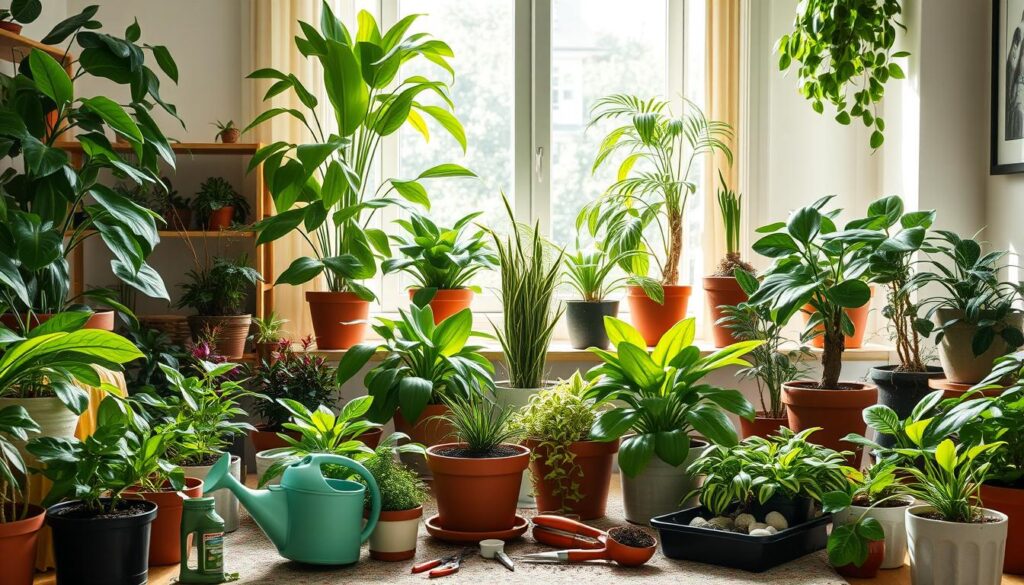
Repotting: When & How to Do It
Repotting is needed when roots start circling the container. Choose a container that’s 1-2 inches bigger than the root ball to prevent root rot and ensure good water absorption. Repotting once a year is a good idea to refresh the soil and give roots room to grow.
Cleaning dust off leaves regularly also helps them absorb light better.
Recommended Houseplant Tools & Accessories
Keeping your indoor plants healthy is more than just picking pretty pots. The right tools and accessories can really help. We’ll cover the basics, from the best pots to the best lights for your plants.
Best Self-Watering Pots
Self-watering pots are a big help for those who don’t have a lot of time for plants. They keep your plants watered just right, cutting down on the chance of too much water. It’s good to change your pot every 1-3 years, and these pots have special features to stop roots from rotting.
Most plants need good drainage, and these pots have it. Look for ones with built-in water reservoirs and wicking systems.
Best Grow Lights for Houseplants
Light is key for your plants, but not everyone has enough natural light. Grow lights that mimic sunlight are a must-have. About 60% of gardeners like lights that can be adjusted for different plants.
Check out different types of grow lights, like LED panels and clip-on models. This way, your plants will get the light they need all year.
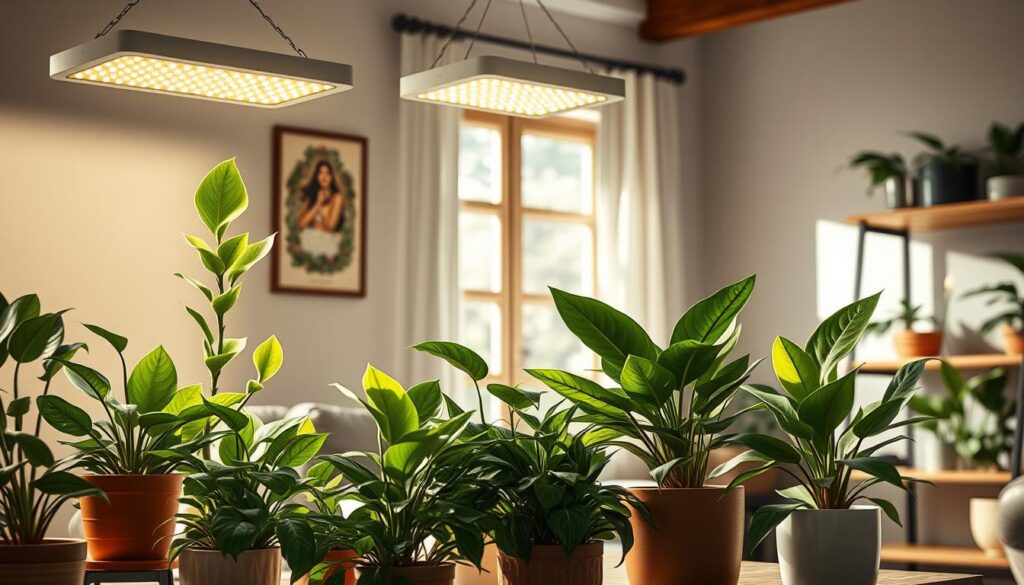
Best Soil Mix for Indoor Plants
The soil mix is crucial for your plants’ health. The right mix can stop problems like too much water, which affects 60% of plant issues. Choose a mix with peat moss, perlite, and vermiculite for better drainage and air.
Miracle-Gro is a favorite among 80% of gardeners for regular care and growing new plants.
Consider getting a plant care set with a mister, microfiber gloves, and neem oil. These sets help keep your plants healthy in a complete way.
For more tips on houseplant accessories, check out this guide.
| Accessory | Usage | Recommendation |
|---|---|---|
| Self-Watering Pots | Prevent overwatering and root rot | Reservoir & wicking systems |
| Grow Lights | Provide essential light for growth | LED panels, Clip-on models |
| Soil Mix | Ensure proper drainage and nutrients | Peat moss, perlite, vermiculite |
| Books on Plant Care | Enhance knowledge and skills | Comprehensive guides by reputable authors |
Using the best tools and accessories can make your indoor gardening better. Get the right pots and lights to help your plants grow well.
Best Books on Houseplant Care
Knowing how to care for your plants is just as important as having the right tools. Good books on plant care can teach you a lot. They cover everything from basic care to advanced techniques.
Browse Houseplants A-Z
Explore our detailed list of 100 houseplants, each with its own care guide. If you’re wondering how to keep your plants healthy or why leaves turn yellow, this guide is for you. It’s your ultimate resource.
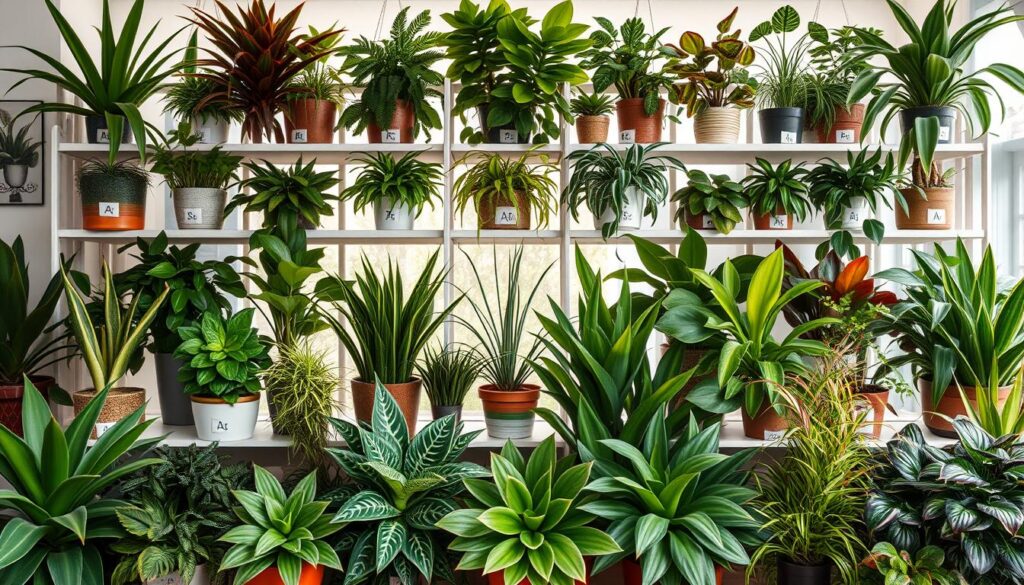
| Plant Name | Difficulty Level | Light Requirement | Best For |
|---|---|---|---|
| African Violet | Medium | Indirect | Living Rooms |
| Aloe Vera | Easy | Direct | Kitchen Windows |
| Amaryllis | Medium | Bright Indirect | Winter Blooming |
| Angel Wing Begonia | Moderate | Indirect | Offices |
| Anthurium | Medium | Bright Indirect | Tabletops |
| Areca Palm | Easy | Bright Indirect | Living Rooms |
| Arrowhead Plant | Medium | Low to Indirect | Bedrooms |
| Aspidistra | Easy | Low Light | Difficult Conditions |
| Baby Rubber Plant | Easy | Bright Indirect | Desktops |
| Bamboo Palm | Easy | Bright Indirect | Air Purification |
| Bird of Paradise | Hard | Bright Direct | Large Spaces |
| Bird’s Nest Fern | Medium | Bright Indirect | Bathrooms |
| Blue Star Fern | Medium | Bright Indirect | Shaded Areas |
| Boston Fern | Moderate | Bright Indirect | Bathrooms |
| Bromeliad | Medium | Bright Indirect | Decorative Spots |
| Burro’s Tail | Medium | Bright Indirect | Hanging Pots |
| Button Fern | Easy | Bright Indirect | Terrariums |
| Calathea | Medium | Low to Indirect | Bedrooms |
| Cast Iron Plant | Easy | Low | Low-Maintenance Spaces |
| Chinese Evergreen | Medium | Low to Medium | Desks |
| Christmas Cactus | Medium | Bright Indirect | Holiday Decor |
| Clivia | Medium | Bright Indirect | Sunny Windows |
| Creeping Fig | Easy | Bright Indirect | Wall Hanging |
| Crown of Thorns | Medium | Bright Direct | Sunrooms |
| Ctenanthe | Medium | Low to Indirect | Low-Light Spaces |
| Dracaena | Easy | Medium to Bright Indirect | Office Spaces |
| Dumb Cane | Easy | Medium Indirect | Low-Light Spaces |
| Dwarf Banana Plant | Hard | Bright Direct | Tropical Indoors |
| Echeveria | Easy | Bright Direct | Succulent Gardens |
| Elephant Ear Plant | Hard | Bright Indirect | Large Decorative |
| English Ivy | Easy | Bright Indirect | Hanging Baskets |
| Fairy Washboard | Easy | Bright Indirect | Small Spaces |
| Fiddle Leaf Fig | Hard | Bright Indirect | Large Spaces |
| Fishtail Palm | Medium | Bright Indirect | Tropical Vibes |
| Flamingo Flower | Medium | Bright Indirect | Colorful Decor |
| Gardenia | Hard | Bright Indirect | Fragrant Blooms |
| Ghost Plant | Easy | Bright Direct | Succulent Arrangements |
| Gold Dust Croton | Medium | Bright Indirect | Colorful Foliage |
| Golden Pothos | Easy | Low to Bright Indirect | Bathrooms |
| Greenovia | Easy | Bright Direct | Drought-Tolerant |
| Heartleaf Philodendron | Easy | Medium to Bright Indirect | Bookshelves |
| Hoya | Medium | Bright Indirect | Hanging Pots |
| Jade Plant | Easy | Bright Direct | Windowsills |
| Japanese Aralia | Medium | Low to Indirect | Exotic Look |
| Kalanchoe | Easy | Bright Direct | Flowering Displays |
| Kangaroo Fern | Medium | Bright Indirect | Hanging Baskets |
| Kentia Palm | Medium | Bright Indirect | Large Rooms |
| Lipstick Plant | Medium | Bright Indirect | Hanging Pots |
| Lucky Bamboo | Easy | Indirect | Desktops |
| Madagascar Dragon Tree | Easy | Medium Indirect | Minimalist Decor |
| Maidenhair Fern | Medium | Bright Indirect | Bathrooms |
| Majesty Palm | Medium | Bright Indirect | Living Rooms |
| Mini Monstera | Easy | Bright Indirect | Small Apartments |
| Monstera Deliciosa | Medium | Bright Indirect | Corner Decor |
| Neon Pothos | Easy | Low to Indirect | Vibrant Greenery |
| Nerve Plant | Medium | Bright Indirect | Terrariums |
| Norfolk Island Pine | Hard | Bright Indirect | Holiday Decor |
| Orchid | Medium | Bright Indirect | Elegant Displays |
| Paddle Plant | Easy | Bright Direct | Sunny Windows |
| Parlor Palm | Easy | Low to Indirect | Hallways |
| Peace Lily | Medium | Low to Medium Indirect | Living Rooms |
| Peacock Plant | Medium | Low to Indirect | Patterned Leaves |
| Peperomia | Easy | Bright Indirect | Compact Spaces |
| Philodendron | Easy | Medium to Bright Indirect | Shelving |
| Pixie Lily | Easy | Bright Indirect | Desks |
| Ponytail Palm | Easy | Bright Direct | Minimalist Decor |
| Prayer Plant | Medium | Low to Indirect | Bedrooms |
| Prickly Pear Cactus | Easy | Bright Direct | Succulent Gardens |
| Purple Passion Plant | Medium | Bright Indirect | Velvety Texture |
| Radiator Plant | Easy | Bright Indirect | Compact Spaces |
| Red Aglaonema | Medium | Bright Indirect | Colorful Interiors |
| Rex Begonia | Medium | Bright Indirect | Patterned Displays |
| Rubber Plant | Easy | Bright Indirect | Corners |
| Ruffled Fan Palm | Medium | Bright Indirect | Tropical Accent |
| Satin Pothos | Easy | Low to Indirect | Trailing Beauty |
| Snake Plant | Easy | Low to Indirect | Bedrooms |
| Spider Plant | Easy | Bright Indirect | Hanging Baskets |
| Spiderwort | Easy | Bright Indirect | Hanging Pots |
| String of Hearts | Medium | Bright Indirect | Trailing Decor |
| String of Pearls | Medium | Bright Indirect | Hanging Baskets |
| Sweetheart Plant | Easy | Bright Indirect | Romantic Decor |
| Swiss Cheese Plant | Medium | Bright Indirect | Indoor Jungle |
| Twisted Lipstick Plant | Medium | Bright Indirect | Unusual Blooms |
| Variegated Rubber Tree | Easy | Bright Indirect | Striking Leaves |
| Velvet Leaf Philodendron | Medium | Bright Indirect | Soft Texture |
| Watermelon Peperomia | Easy | Bright Indirect | Tabletop Displays |
| Weeping Fig | Medium | Bright Indirect | Living Spaces |
| White Fusion Calathea | Medium | Low to Indirect | Unique Patterns |
| ZZ Plant | Easy | Low to Indirect | Offices |
| Zebra Plant | Hard | Bright Indirect | Striped Leaves |
Adding houseplants to your home brings many benefits. They not only make your space look better but also improve the air and reduce stress. Studies show that plants can cut stress by up to 60%. Some plants, like the Snake Plant and Peace Lily, are great at removing harmful chemicals from the air. We are committed to help with information to show you how to choose the right houseplant for your home
Choosing the right plants is key to success. Start with easy-to-care-for plants like the Snake Plant or Peace Lily. Learn what each plant needs for light, water, and humidity. For example, Pothos plants can handle low light and don’t need water for up to four weeks.
Indoor plants can also make your home more comfortable and boost your mood and productivity by 70%. They thrive in moderate humidity and temperatures between 65–75°F (18–24°C). Regular care, like repotting and fertilizing, helps them grow well. For more tips, check out The Ultimate Guide to Indoor Plant Care Tips and.
Starting your houseplant journey is a rewarding experience. By understanding your plants’ needs, you’ll see them flourish and make your home lively and healthy. So, begin your indoor gardening adventure today and enjoy the benefits of having plants around.
If you are a gardening fan check out Michelle’s Youtube channel for all things plants.


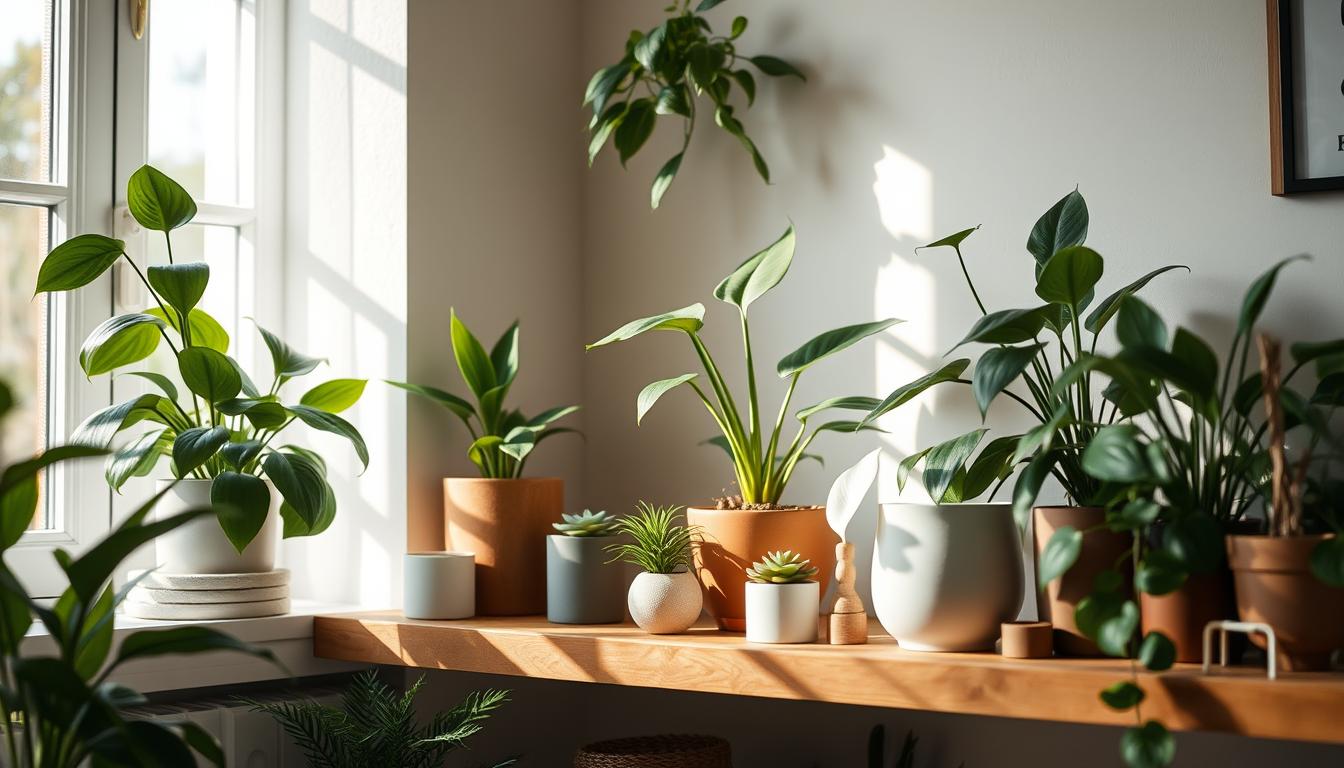
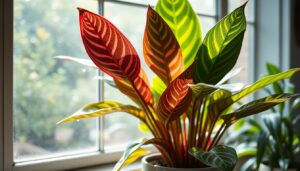
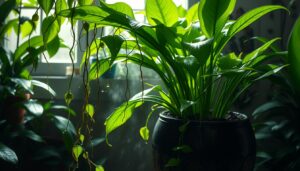
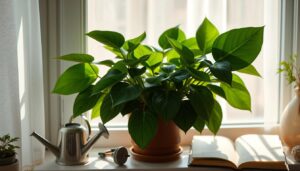
Pingback: 12 Best Houseplants for Beginners to Brighten Your Home – Trusted House Plant Guide
Pingback: 10 Gorgeous Houseplants That Thrive in Humidity – Trusted House Plant Guide
Pingback: 10 Best Air-Purifying Houseplants for a Healthier Home – Trusted House Plant Guide
Pingback: 8 Best Pet-Friendly Houseplants for a Happy Home – Trusted House Plant Guide
Pingback: 8 Stunning Flowering Indoor Plants to Brighten Your Home – Trusted House Plant Guide
Pingback: 10 Perfect Small Houseplants for Compact Spaces – Trusted House Plant Guide
Pingback: 12 Stunning Indoor Succulents and Cacti for Your Home – Trusted House Plant Guide
Pingback: 10 Best Low-Light Houseplants for a Lush Indoor Oasis – Trusted House Plant Guide
Pingback: 10 Cold-Tolerant Houseplants for Cozy Indoor Spaces – Trusted House Plant Guide
Pingback: 10 Statement Houseplants to Create Your Dream Indoor Jungle - Trusted House Plant Guide
Pingback: 8 Houseplant Trends That Will Dominate 2025 – Get Ahead of the Curve! - Trusted House Plant Guide
Pingback: Bird’s Nest Fern care, The Easy-Care Fern That Loves Moisture and Shade